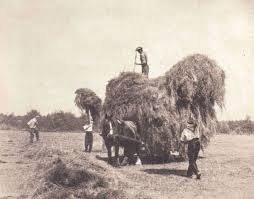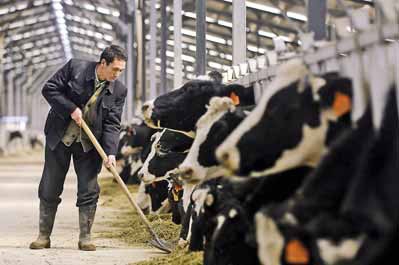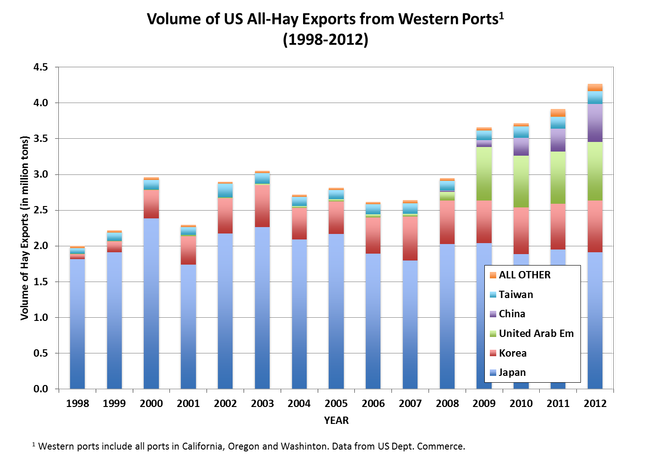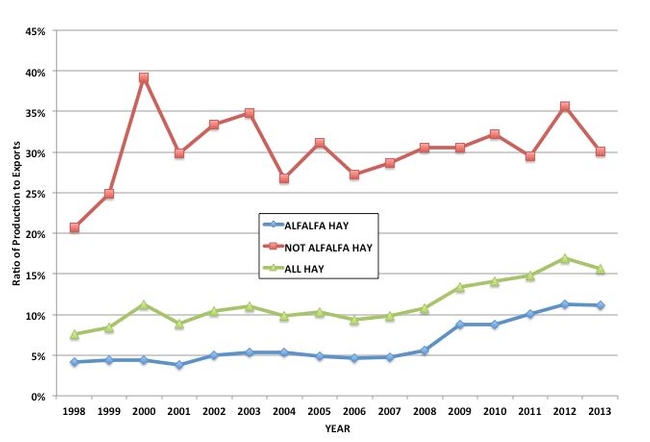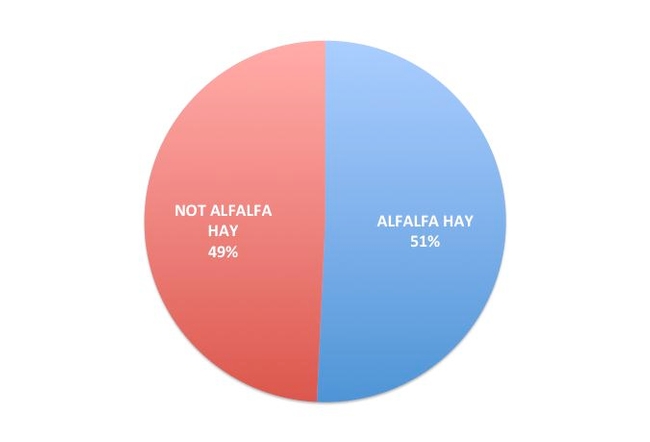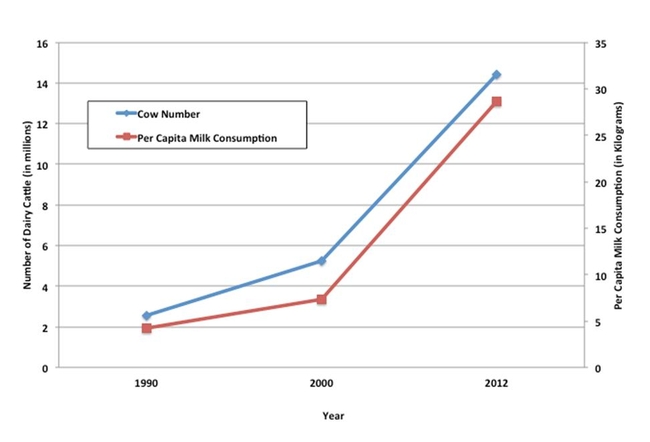For those of you not yet convinced that we live in an increasingly international economy, button up your Dacca-made parka– globalization is bringing alfalfa and hay crops increasingly into the world of global trade.
If you don’t know where Dacca is– look it up on your Shenzhen-made iPhone!
While many crops (corn, wheat, soybeans, almonds and citrus) have long been traded on the world market, forages have been historically fed within a few miles of the animals they nourished (Figure 1). After all, hay and silage are bulky commodities.
|
Figure 1. Hay has historically been grown a short distance from the animals it feeds. |
But hay is increasingly moving overseas (Figure 2). The advent of inexpensive containerized shipping, technology for compression of hay and growing world demand has changed the equation, at least for the Western United States. Currently, the equivalent of over 12% of the alfalfa and over 30% of grassy hays produced in the seven western states are exported.
|
Figure 2. Containerized compressed alfalfa hay awaiting export from the US (top) and being fed to Chinese dairy cows (bottom). While Japan is the major recipient of US hay, China, Korea, and the UAE have become major importers in recent years. |
How Much Hay is Now Exported?
In 2012, over 4 million Metric Tons (MT) of hay were shipped overseas, approximately double what it was in 1999 (Figure 3 – note, to convert MT to short tons, multiply by 1.102). For reference, the state of Nevada produced about 1.2 million MT and California 8.7 million MT in 2012.
Asia and Pacific Rim countries have been the primary destination for U.S. hay exports. Almost all (>99 percent) of US hay exports are shipped from Western ports, with Japan as the largest buyer. From 1998 to 2012, Japan purchased, on average, slightly less than 1.8 million MT annually including alfalfa, timothy, sudangrass and kleingrass (Figure 3).
Figure 3. Volume of US Hay Exports from Western Ports by Top 5 Destination Countries, 1998-2012. Over 99% of all hay exports are from western ports. Western ports include all ports in California, Oregon and Washington. Source: US Dept. of Commerce.
Dramatic Increase over 5 Years. Overall volume of U.S. hay exports have increased by over 60 percent since 2007. This increase is largely due to growth in two markets: United Arab Emirates and China (Figure 3). UAE purchased just over 743,000 MT in 2012, a 20-fold increase from 2007, when it purchased just 37,000 MT of U.S. hay. China’s imports increased 200 times from 2,400 MT in 2007 to just over 485,000 MT in 2012 (all figures from US Dept. of Commerce).
In 2013, exports to these two countries have intensified. If early 2013 data continues apace, the totals may put just these two countries at over 1.7 million MT of combined imported US hay demand this year (Table 1). Alfalfa exports increased 14% and total hay exports about 7% between 2012 and 2013 (first six months), but exports to UAE and China increased 40-60% (Table 1).
Share of US Production Exported. The share of US-produced alfalfa that is exported grew from 1.5% in 2007 to 4.5% in 2012 (Figure 4). The equivalent share of Western-grown alfalfa is much larger, at 12.5% in 2012, up from about 5% in 2007 (Figure 5). Although some hay may originate further east, the lion’s share of exported hay is thought to be from the Western U.S. states (Arizona, California, Idaho, Nevada, Oregon, Utah and Washington). In specific regions, particularly the Imperial Valley of California, and the Columbia basin of Washington-Oregon, the percentage of alfalfa and grassy hays exported may be over 50% of production.
Exports are even more important for grass hays. Over 30% of western grass hay production is shipped overseas (Figure 5). While grassy hays (e.g. timothy, sudangrass, orchardgrass, kleingrass) are nearly half of the exports from Western states, they are less than ¼ of the production in this region (Figure 6).
Figure 4. Share of US hay production exported, 1998-2012. Source: US Dept. of Commerce and USDA-NASS.
Figure 5. Ratio of Western Exports to Western Production shown as a Percentage. Source: US Dept. of Commerce and USDA-NASS.
Figure 6. 2012 Hay Production by Type in U.S. Western States (top) and 2012 US Export of hay through western ports by type. Western US include the states Arizona, California, Idaho, Nevada, Oregon, Utah and Washington, and Western ports include all ports in California, Oregon and Washington.
What are the key drivers?
Demand is the Common Denominator. The UAE, China, and Korea all have increasing demands for milk products and feed for local herds. In the UAE, the high population of camels, horses, sheep, and goats is important, in addition to dairy and beef cattle, as demands for both milk and meat are increasing. Milk is also the key issue in China. Although China is not historically a milk-consuming culture, the per capita demand for milk products has been rising dramatically: from 4.2 kg in 1990 to 28 kg in 2012 (Figure 7). The Chinese government has encouraged more modern and larger dairy production units, to improve quality after a 2008 adulteration scandal. This has accompanied a significant rise in dairy cow numbers, up from about 2-5 million to 14 million today, according to government sources (Figure 6).
Water in the Mideast. The UAE government decided in 2008 to stop producing alfalfa hay in the kingdom, due to their increasingly scarce water resources. Given local herd dependence on forage, this created an immediate demand for imported hay. In that part of the world, pumped water largely originates from fossil sources, which will never be renewed in human history.
Knowledgeable sources expect a similar decision from the government of Saudi Arabia in the very near future. An abrupt decision to stop hay production in the kingdom would cause the rapid development of new hay markets much larger than that in the UAE, perhaps in the 3-4 million MT range. Parts of the world outside the western States (Mideast, North Africa, Europe, South America) may satisfy much of this demand. However, this illustrates the importance of water to the future of food production, and the resulting globalization of the feed supply.
China Dairy Growth. Water is also a major limiting factor in China. However, the increase in dairy demand, increased cow numbers in China, and limitations in arable land near the cities where dairy cows are located are major factors in the increased demand for high quality alfalfa imports.
The imbalance of trade with Asia means that the price of ocean shipping to Asia is cheaper than over-land transport costs within China, or even within the US. (This factor does not apply to shipments to the Mideast). Further, summer rains make hay production difficult in China (as it is in many parts of the eastern United States), and infrastructure for hay baling, handling and transport is limited. Long distance transport from alfalfa-producing areas to dairies is also an important cost factor domestically, since ocean shipping is cheaper than overland shipping.
Chinese Efforts to Improve Alfalfa. Although the Chinese government is embarking on a major program to improve domestic alfalfa production (more on that later), most experts believe that the domestic production will not satisfy domestic Chinese demand, at least for the next 5-15 years. Figure 6 highlights the 6-7 fold increase in milk demand and dairy cow numbers in just two decades (Figure 7).
A key factor to watch will be milk prices in China. While China imports significant dried milk products, government policies and consumers favor production of fresh milk products near population centers for quality reasons. Farm milk prices have lately been about double those received by California dairy farmers, making it economically feasible for Chinese dairies to purchase hay delivered to the dairy at prices between $350 and $500 per ton.
What are the implications here at home? This is a more complex question. Western hay farmers have been happy to see the new markets open up, because new demand tanslates into firmer prices. Western dairy farmers, who face many pressures, are certainly not overjoyed at having to compete with foreign buyers for a limited supply of hay. Some critics have questioned the export of ‘water’ in the form of hay (see Wall Street Jounal ‘Shipping water to China Bale by Bale” http://online.wsj.com/news/articles/SB10000872396390444517304577653432417208116 – see also this BLOG //ucanr.edu/blogs/blogcore/postdetail.cfm?postnum=8825 for further discussion).
In many respects, hay crops are following (to a much more modest extent), the pathway of other crops (corn, soybeans, wheat, rice, citrus, and almonds), which have long been truly global commodities. Dairy exports themselves have also increased rapidly, so we may be exporting hay directly or hay in the form of milk powder or cheese. Dairy exports are now the #2 export commodity (by value) from California agriculture.
What about the Future of Hay Exports? While exports are not a dominant component of hay demand nationally, it is increasingly important in the West. The rapid increase in hay export importance reflects globalization of diets, and globalization of our food system generally. These data illustrate the historical progression of alfalfa and other hay from being grown and fed on-farm, to being traded locally, to long-distance transport, and then to a crop traded internationally. To some degree this is a logical extension of markets in the western US, where over 90% of the hay is marketed off the farm anyway. This is not true of the Midwest or East where most forage is fed on-farm.
Prognostication is a dangerous thing. However, the confluence of 1) generally high quality of Western-grown US hay, 2) technology for hay handling that reduces cost of shipping, 3) efficient and inexpensive modes of ocean shipping, 4) demand for high quality milk and meat products in new markets, and 5) scarcity of land or water in many regions, provides a set of circumstances that is likely to further increase the importance of Western US hay exports in the future.
Figure 7. Change in Chinese milk consumption and cow numbers, 1990-2012. Source: Chinese Grassland Association. Note: data may differ depending upon source.
